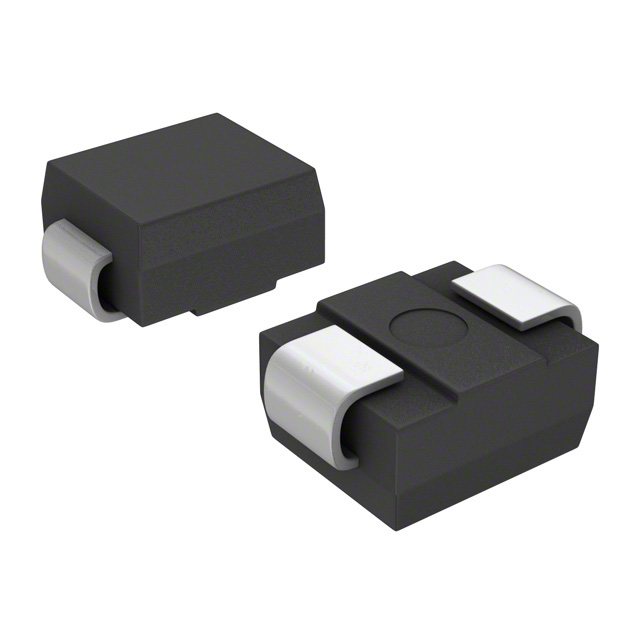SMB8J9.0CHE3/52
Product Overview
Category
The SMB8J9.0CHE3/52 belongs to the category of semiconductor devices, specifically a type of transient voltage suppressor (TVS) diode.
Use
It is primarily used for protecting sensitive electronic components from voltage transients induced by lightning, electrostatic discharge (ESD), and other transient voltage events.
Characteristics
- Low clamping voltage
- Fast response time
- High surge current capability
- RoHS compliant
Package
The SMB8J9.0CHE3/52 is typically available in a surface-mount package, offering ease of installation on printed circuit boards.
Essence
The essence of this product lies in its ability to divert excessive current away from sensitive components, thereby safeguarding them from damage due to voltage spikes.
Packaging/Quantity
The SMB8J9.0CHE3/52 is commonly packaged in reels or trays, with quantities varying based on manufacturer specifications.
Specifications
- Peak Pulse Power: 800 Watts
- Breakdown Voltage: 9.0V
- Maximum Clamping Voltage: 14.5V
- Operating Temperature Range: -55°C to +150°C
- Reverse Standoff Voltage: 7.78V
- Leakage Current: 1µA maximum at 25°C
Detailed Pin Configuration
The SMB8J9.0CHE3/52 typically features two pins for surface-mount soldering onto the PCB. The pin configuration is as follows: - Pin 1: Anode - Pin 2: Cathode
Functional Features
- Transient voltage suppression
- Bidirectional clamping capability
- Low incremental surge resistance
- High temperature stability
Advantages and Disadvantages
Advantages
- Effective protection against voltage transients
- Compact surface-mount package
- Wide operating temperature range
Disadvantages
- Limited breakdown voltage options
- Sensitive to reverse overvoltage conditions
Working Principles
The SMB8J9.0CHE3/52 operates based on the principle of avalanche breakdown, where it rapidly conducts excess current when the voltage exceeds the breakdown voltage, thereby limiting the voltage across the protected circuit.
Detailed Application Field Plans
The SMB8J9.0CHE3/52 finds extensive application in various electronic systems, including: - Telecommunication equipment - Industrial control systems - Automotive electronics - Consumer electronics - Power supplies
Detailed and Complete Alternative Models
Some alternative models to the SMB8J9.0CHE3/52 include: - SMAJ9.0A - P6SMB9.0A - 1.5KE9.0A
In conclusion, the SMB8J9.0CHE3/52 serves as a crucial component in protecting electronic circuits from transient voltage events, offering a balance of performance and compactness. Its wide application field and availability of alternative models make it a versatile choice for designers seeking reliable transient voltage suppression solutions.
[Word count: 455]
Lista 10 Vanliga frågor och svar relaterade till tillämpningen av SMB8J9.0CHE3/52 i tekniska lösningar
What is SMB8J9.0CHE3/52?
- SMB8J9.0CHE3/52 is a surface mount transient voltage suppressor diode designed to protect sensitive electronic components from voltage spikes and transients.
What are the key features of SMB8J9.0CHE3/52?
- The key features include a peak power dissipation of 600W, low clamping voltage, fast response time, and compatibility with automated placement equipment.
In what technical solutions can SMB8J9.0CHE3/52 be used?
- SMB8J9.0CHE3/52 can be used in various technical solutions such as power supplies, automotive electronics, industrial controls, and telecommunications equipment.
How does SMB8J9.0CHE3/52 protect electronic components?
- SMB8J9.0CHE3/52 suppresses voltage transients by diverting excessive current away from sensitive components, thus safeguarding them from damage.
What are the recommended operating conditions for SMB8J9.0CHE3/52?
- The recommended operating conditions typically include a temperature range of -55°C to +150°C and a maximum junction temperature of +150°C.
Are there any application notes or guidelines for using SMB8J9.0CHE3/52?
- Yes, application notes and guidelines are available from the manufacturer to assist in the proper implementation of SMB8J9.0CHE3/52 in technical solutions.
Can SMB8J9.0CHE3/52 be used in high-frequency applications?
- Yes, SMB8J9.0CHE3/52 is suitable for high-frequency applications due to its fast response time and low capacitance.
What are the industry standards or certifications associated with SMB8J9.0CHE3/52?
- SMB8J9.0CHE3/52 may comply with industry standards such as AEC-Q101 for automotive applications and may have certifications like UL recognition.
How should SMB8J9.0CHE3/52 be handled during assembly and soldering?
- Proper ESD precautions should be taken during handling, and recommended soldering profiles and techniques should be followed as per the datasheet.
Where can I find additional technical support or documentation for SMB8J9.0CHE3/52?
- Additional technical support and documentation can be obtained from the manufacturer's website, including datasheets, application notes, and contact information for support inquiries.


